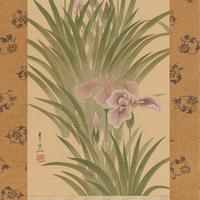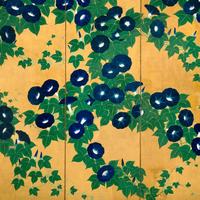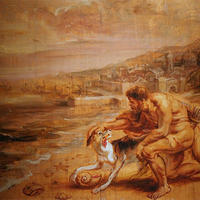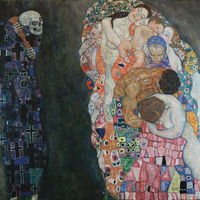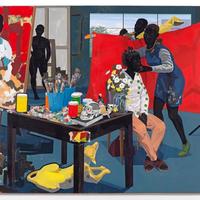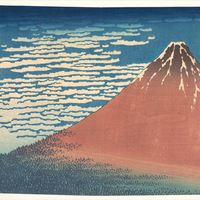More about Suzuki Kiitsu
Works by Suzuki Kiitsu

Contributor
You can read the life of Suzuki Kiitsu (鈴木其一) as a helpful reminder that everybody relies on somebody at some point or another.
For a long time, scholars assumed that Kiitsu came from humble agrarian origins in Ōmi Province, which is now Shiga Prefecture, near Kyoto. Recent research suggests that the artist came from a line of samurai. Still, this is not yet, and may never be, proven, so we start with the common eighteen-year-old Kiitsu entering the school of, and moving into the house of, Sakai Hōitsu, just a few years after Napoleon lost his license to rampage on the other side of the globe. Later on, Kiitsu would collaborate with Hōitsu on the published work "Kōrin hyakuzu" ("One hundred pictures by Kōrin"), and become a master of the Yamato-e movement himself, producing especially beautiful byōbu, folding paper screens.
Hōitsu was to the Rimpa or Rinpa School what Mary Lou Williams was to the blues: he saw something he loved from a generation earlier and revived it in Edo, which is a name for present-day Tokyo, during the Tokugawa shogunate's Edo period. The Rimpa School borrows its name, in part, from the last syllable of the name of Ogata Korin (1658-1716), who tag-teamed with his brother Ogata Kenzan (1663-1743) to breathe new life into the earlier artistic insights of Tawaraya Sotatsu and Hon’ami Koetsu. Rimpa is distinguished by its use of gold and silver foil in the background, its bold composition, and its hypnotic use of pattern repetition.
Kiitsu's older "classmate," who doubled as a feudal servant for Hōitsu, Suzuki Reitan (1782-1817), was a Sakai clan samurai whose tragically early death put Kiitsu in an unusual position, by today's standard. In order to continue the family name according to the patriarchal system, the House of Suzuki needed a male heir, so they adopted Kiitsu in conjunction with his marriage to Reitan's sister, somewhat like the Biblical Levirate marriage system. Unfortunately, the woman's name seems to be unavailable in English-language sources. Compared with a more recent figure in the art world, the New York super-collector Robert Scull, Kiitsu's social climbing was totally orthodox. Scull inherited megamillions from his taxicab tycoon in-laws, and faced resentment for that and his choice to buy art for the status of it, defending himself and his wife by saying "I’d rather use art to climb than anything else.” By contrast, Kiitsu's peers would have seen his social-climbing marriage and adoption as an honorable thing to do, to continue the name of his friend's family.
When he outlived his master, Kiitsu began signing different names to his canvases, which developed in beauty and spiritual depth, using playful monikers like "kaikai" and "seisei" (spiritual refinement). Kiitsu's masterpieces include many multi-paneled folding screens with images of beautiful outdoor scenes. Kiitsu's cranes and shellfish are especially brilliant. His work is a significant influence on artists, like Hishida Sunsō and Hayami Gyoshū, of the Nihonga movement which followed his own. Kiitsu's son, Suzuki Shuitsu (1823–1899), was his disciple.
Sources
- "幕末の異端児 鈴木其一." Cocolog, Oct. 12, 2016, http://liveatloft.cocolog-nifty.com/blog/2016/10/post-2609.html.
- "鈴木其一 江戸琳派の旗手." Suntory Museum of Art, Sep. 10, 2016, https://www.suntory.co.jp/sma/exhibition/2016_4/.
- "夏秋渓流図." Nezu Museum, http://www.nezu-muse.or.jp/sp/collection/detail.php?id=10348.
- “鈴木其一 江戸琳派の旗手." Hosomi Museum, 2020, https://www.emuseum.or.jp/exhibition/ex051/index.html.
- Carpenter, John T. Designing Nature: The Rinpa Aesthetic in Japanese Art. New York: Metropolitan Museum of Art, 2012.
- Hammond, Jeff Michael. "Suzuki Kiitsu: Bringing modernity to Rimpa." The Japan Times, Sep. 20, 2016, https://www.japantimes.co.jp/culture/2016/09/20/arts/suzuki-kiitsu-brin….
- "Suzuki Kiitsu: Standard-bearer of the Edo Rimpa School." Suntory Museum of Art, Apr. 2016, https://www.suntory.com/sma/exhibition/2016_4/display.html.
Featured Content
Here is what Wikipedia says about Suzuki Kiitsu
Suzuki Kiitsu (Japanese: 鈴木其一, 1796–1858) was a Japanese painter of the Rinpa school.
A student of the famous painter Sakai Hoitsu (1761–1828), he was for a long time considered a minor member of Rinpa school of Japanese painting. In recent years his work has been reevaluated and gained recognition, leading to a series of major exhibitions of his art in 2016–2017 in Tokyo, Hyogo and Kyoto.
Kiitsu is best known for his byōbu folding screens, often a reinterpretation of screens by other Rinpa artists, such as his massive Wind God and Thunder God following Tawaraya Sōtatsu (c. 1570 – c. 1640), Ogata Kōrin (1658–1716) and Hoitsu. But he has been most acclaimed for his original screens, including his famed Morning Glories and Mountain Stream in Summer and Autumn.
He was also a notable master with many pupils. Although he was not the official successor of Hoitsu's school, he trained himself many of the Edo Rinpa artists. This has sometimes been labeled as the Kiitsu school of Edo Rinpa.
Check out the full Wikipedia article about Suzuki Kiitsu


